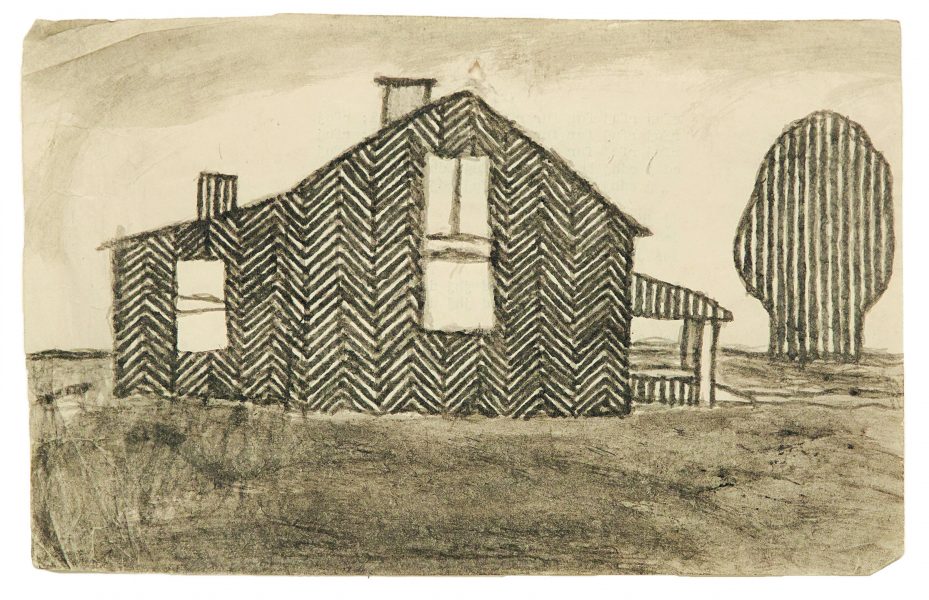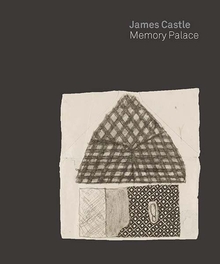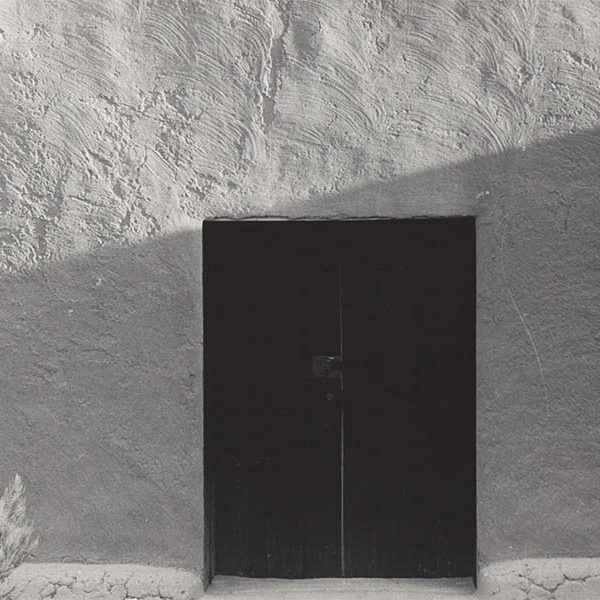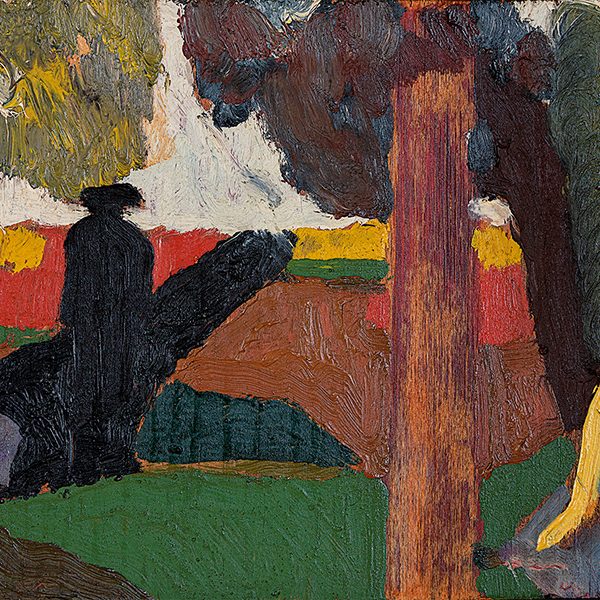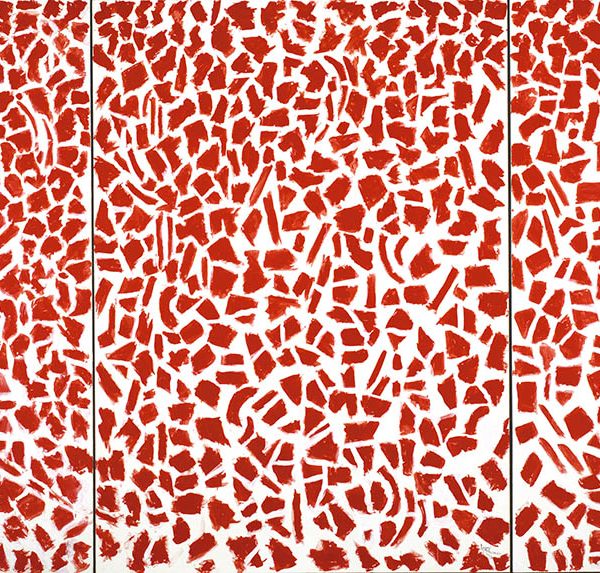James Castle’s Silent Universe
Interview with John Beardsley by David Ebony
Today, James Castle (1899-1977) is renowned for the richly nuanced surface textures of his gray-scale drawings, his moody and mystical views of the environs of his home in rural Idaho, and the eccentric renderings and paper constructions of figures and animals that captured his imagination throughout his life. In the past three decades he has emerged as a unique figure in mid-twentieth-century American art. He also represents an extraordinary conundrum for art historians and critics, since his output is nearly impossible to accurately categorize and stands apart from what is generally regarded as the “contemporary art world.” Deaf since birth, and apparently unable to be educated in any conventional sense, Castle studied books on art, and eventually created his own elaborate techniques for art-making. For his drawings, he made a kind of ink, mixing soot from his family’s wood-burning stove with his own saliva to form a paste-like medium. He used bits of wood and sticks instead of pencils and brushes. He also created colorful pulp—paper pieces, and elaborate constructions made of bits of sewn cardboard, plus text pieces, including many small bound books of text and images with esoteric and idiosyncratic meaning.
Although self-taught, Castle was not exactly an Outsider artist, since he showed his work several times in mainstream galleries and public institutions during his lifetime. He was never married or partnered, but he was well cared for by his family, who nurtured his artistic pursuits. He remained isolated, however, in a silent, solitary universe of his own creation, and was extremely prolific, producing many hundreds of artworks, most in an intimate scale. He sometimes stored them in bundles that he tucked away in secret hiding places in his home. After his death, as his work began to appear in exhibitions in the context of Outsider art, Castle was quickly embraced by the contemporary avant-garde for his innovative techniques and unique approach to the figure. Since the mid-1990s, his work has been shown in high-profile mainstream galleries of contemporary art in the U.S. and abroad. He has also received major solo exhibitions at prestigious public institutions, such as the Philadelphia Museum of Art (2008) and Madrid’s Museo National Centro de Arte Reina Sofia (2011); his work was also featured in the Venice Biennale in 2013.
This year, Yale University Press, in collaboration with the James Castle Collection and Archive, which opened in 2012 in Boise, Idaho, published an extensively illustrated study of the artist’s life and work, James Castle: Memory Palace, written by art historian and museum curator John Beardsley. The book focuses on Castle’s extraordinary memory capacity, and the way in which it reveals itself and unfolds within his remarkable oeuvre. In a recent phone interview, I spoke with Beardsley about the book and Castle’s unique contribution to twentieth-century art.
David Ebony I’ve written about James Castle’s work a number of times in the past; the literature on Castle until relatively recently was quite scant. Your book James Castle: Memory Palace is the most comprehensive I’ve seen in recent years. It’s an invaluable resource for anyone interested in the artist. Would you say it is the definitive book on Castle?
John Beardsley I wouldn’t make that claim.
Ebony OK. I will! How did you get involved with Castle’s work?
Beardsley I have followed his work over the years, and was always very much interested in it, so when I was approached about the possibility of writing the text for this book, I jumped at the chance.
Ebony What has been your focus until now?
Beardsley I’ve worked as a curator, author, and educator. One of my main focuses has been the history of landscape, as well as environmental art and landscape architecture. I taught at the Harvard Graduate School of Design for many years, and ran a research program in landscape studies at Dumbarton Oaks in Washington D.C. But I’ve also had an abiding interest in the art of the self-taught. Back in 1982, [curator] Jane Livingston and I organized an exhibition “Black Folk Art in America” [at the Corcoran Gallery of art in Washington, D.C.]. That show presented the work of twenty mostly elderly, mostly rural Southern self-taught African-American artists. I followed that up by working on exhibitions that featured the “The Quilts of Gee’s Bend,” in 2002, and the work of Thornton Dial, in 2005.

CAS19-0199 © James Castle Collection and Archive, all rights reserved
I also wrote a book, Gardens of Revelation [1995], about visionary environment makers. I was interested in the field of the self-taught, and the challenges it presents in terms of understanding and presenting cultural diversity. I was drawn to Castle for a number of reasons—the geographic and social isolation that he experienced, the connections between creativity and deafness, and because of his extraordinary memory and his incredible facility and capabilities as an artist despite the lack of formal art training, or education of any kind.
Ebony Did you go to Idaho, to see where he lived and worked?
Beardsley Yes, several times. Jacque Crist [Jacqueline Crist, J Crist Gallery founder, and former Artist Services Director for the Idaho Commission on the Arts] and her staff were incredibly hospitable.
Ebony Jacque introduced me to Castle’s work years ago, in the 1990s, when she came to New York for one of the early installments of the Outsider Art Fair. There’s so much to say about it, I know, but how would you describe Castle’s work briefly, in terms of an introduction?

Beardsley That’s challenging! I would say that he is one of the most interesting self-taught artists that America has produced. He was born in the mountains of central Idaho in 1899, and he was deaf from an early age. Maybe as a consequence, he developed an incredible visual-spatial memory. He drew from those memories later in his life to create architectural renderings of the both the inside and outside of buildings where he lived and worked. He also cut out cardboard figures and animals, and created elaborate language puzzles. All of his works reveal a highly developed autobiographical memory.
Ebony You titled the book James Castle: Memory Palace. How did that come about? And how did you organize the book?
Beardsley Years ago, I read Jonathan Spence’s book, The Memory Palace of Matteo Ricci. I’ve always been fascinated by mnemonic devices. When I started to write this book, I was working at Dumbarton Oaks with a lot of classicists who helped steep me in the classical art of memory. Coincidently, [curator] Nicholas Bell some years ago, in an essay for a Smithsonian Institution catalogue, mentioned the idea of the memory palace in connection with Castle’s work. So, I built upon these earlier ideas of the memory palace, and how they might be relevant to Castle’s work.
I used the device of the memory palace as a way structuring the book. You move through the different aspects of Castle’s work as if through the rooms of a memory palace—each room filled with images evocative of particular times and places recollected from his life. For instance, there’s a room narrating his biography, a room revealing how he worked, a room about his drawings of landscape and building exteriors, a room about the interiors of buildings, another about his cut-out figures, another about his use of language, and still another room about his appropriations of images created by other people.

© James Castle Collection and Archive, all rights reserved
Ebony You mention that the Castle family moved three different times.
Beardsley Yes. He lived in three different places—the family uprooted twice. He left Garden Valley, the little town in the mountains where he was born, when he was in his mid-twenties; and then lived outside a town called Star, near Boise, for about a half-dozen years, and then moved to a small farm closer to Boise in the early 1930s, and lived there for the rest of his life. It was there that most of Castle’s surviving work was made.

Ebony You say some intriguing things about how Castle would bundle up his works and sometimes hide them in nooks and crannies in the house. I wondered if there have been thorough searches in the other two homes to find hidden works.
Beardsley All of the structures at the Garden Valley homestead are gone, and reportedly some things were found in one of those buildings. And the place they lived at in Star is also gone. Some works were found in the attic and hidden inside the walls of the house in Boise, so there have been discoveries of drawings. But the only house that survives is the one in Boise.
Ebony In the book, you discuss at length the idea of Castle’s superior memory in neurobiological terms, in a way that I’ve never read before. Could you describe that approach?
Beardsley It’s a bit challenging for me to explain it well, since I’m an art historian and not a neurologist, but as I understand it, there seems to be a link between the capacity for spatial thinking and long-term memory formation. So, people who are good at thinking in a spatial sense—as Castle clearly was— are also good at forming memories. There may be some genetic basis to this, a predisposition toward these kinds of powerful autobiographical memories. Others speculate that this kind of memory formation is a result of a powerful emotional experience, such as a sense of loss, or extravagant joy. So, there may be an emotional dimension to this kind of memory formation, or there may be a genetic predisposition. In the book, I present both of those theories of memory formation as a way to enrich potential readings of Castle’s work. I think the Oliver Sacks argument that memory formation is a result of trauma doesn’t really apply to Castle. His life was not all that traumatic. He was deaf, yes, but he lived a comfortable existence, he was surrounded by family, and he was able to work.

18 x 14 in. CAS10-0316 © James Castle Collection and Archive, all rights reserved
Ebony You also seem to discount or doubt the speculations by some that Castle was autistic. And I understand that the family also disputes that notion.
Beardsley There is a long history in presenting the work of the self-taught of exaggerating their struggles, and exaggerating disabilities. The Outsider artist and great environment maker James Hampton [1909-1964], for example, was posthumously diagnosed as schizophrenic on the basis of visions he had and recorded in his work. But there is a strong religious tradition of recounting visions as a way of expressing faith that is more relevant to understanding Hampton’s work than mental illness. In a similar way, some people have wanted to exaggerate trauma or difficulties in Castle’s biographical narrative. I think we all need to be careful not to overdo it, in terms of overemphasizing the biographical challenges of self-taught artists.
Ebony I greatly admired the way you brought [French theorist] Gaston Bachelard [1884-1962] into your discussion of Castle. He’s one of my favorite writers, and you make such a convincing case for connecting the concepts in Bachelard’s most influential book The Poetics of Space with the spatial relationships that Castle explores in his work.
Beardsley Bachelard presents a very useful way of thinking about how memory gets inscribed in architectural space, and especially domestic space. It’s particularly helpful to consider his concept of the house as a space for daydreaming. A lot of what Castle does is a form of daydreaming focused on his memory of domestic spaces. At the same time, I think there are limitations to Bachelard’s model. For him, topoanalysis was a form of topophilia. But we can’t know how Castle felt about these architectural spaces. We don’t know much about Castle’s emotional life or the emotional content of his work. The work seems very quiet and contemplative, and for some, that may be evocative of loneliness; but we need to be careful with what we read into the work.

Ebony In the chapter titled “Sixth Room,” you discuss the area of Castle’s work that in recent years seems to be getting more critical attention, if not acclaim, and that is his use of language—systems and sequences of letters, numbers and symbols. You mention that in 1940 there was a census that said that Castle could, in fact, read and write.
Beardsley Yes. That’s very interesting. I don’t know if it was the census taker who decided that Castle was literate, or if the family by then realized that he had some facility with written language and therefore considered him to be literate. I don’t think he was literate in a conventional sense. But he was certainly fascinated with words, with alphabets, and with various literary forms—poetry or fiction. His books evoke the tradition of illustrated novel, and in fact, some of them resemble contemporary forms of the graphic novel. What he did was play with language—making substitutions of one letter for another, swapping letters from one alphabet and plugging them into another one, whether its Roman, Greek, or Cyrillic. Sometimes he replaced letters with different kinds of symbols, like question marks or dollar signs. He had an incredible imagination for language and various literary forms, but outside of any conventional definition of literacy.
Ebony You highlight the idea of “estheticized language” with regard to Castle. It reminds me of the language games in Jean-Michel Basquiat’s work.
Beardsley I think there’s a whole subgenre in art and literary history of invented words and phrases. It goes back to Dada and the Surrealists, a fascination with subverting conventional language; and it relates to the Concrete Poetry movement in its emphasis on the visual form of language being as important as the meaning of words or phrases. Was Castle trying to subvert language? Was it a game? Is it visual punning? Again, we don’t know for sure. We don’t know what he was thinking. Maybe that’s what makes it so intriguing.

Ebony You also suggest that he might have used language to create what might be call mantras. There’s a kind of devotional quality to his language games that you emphasize.
Beardsley It’s purely speculative on my part, but the way certain combinations of letters, the implications they carry of certain sounds, and the way they are repeated, has a kind of mantralike quality. There is the devotional practice of “speaking in tongues,” which may be relevant here. You receive the spirit through this invented, and, to other people, nonsensical language.
Ebony Was Castle’s family religious?
Beardsley His mother was Catholic; the family recounts that there was an itinerant priest who came through the mountains of central Idaho on a regular basis, and was a guest at their house. And there was a Catholic church not so far away that they apparently went to. But whether James participated that much is unknown—there’s not a lot of evidence of that. He may not have been religious in the conventional sense, but he was certainly aware of religious practice because he copied a lot of drawings from Christmas cards, and drew angels and such.
Ebony That brings me to the question of appropriated imagery in Castle’s work. You discuss his transcription of imagery in terms of mass-media sources, and cartoons and comic books. I wonder what you might think of his approach to appropriation compared with that of other Outsider artists—I’m thinking specifically of his contemporary [Chicago artist] Henry Darger [1892-1973]. They both used images based on the “Morton Salt” girl, which figures prominently in a number of Castle works highlighted in the book. I guess it is one of the most iconic images in mid-twentieth-century advertising.
Beardsley I didn’t make that comparison mainly because Darger’s work is so much more novelistic; so I didn’t go there. But it is an interesting avenue for someone to explore.
Ebony Castle’s work sometimes strikes me as a kind of infinite ocean of associations with so many things—other artworks, people, places, and all sorts of diverse cultural references.
Beardsley The appropriated imagery within Castle’s work was one of the ways he learned how to make art. He was looking at the way other people did things, and copying those things and learning from them. What’s interesting to me is how far behind he eventually left a lot of that. He would learn some techniques from these transcriptions. He would repeat an image a few times, but most of the things he made came from his own memory; he really inhabited his own world.
Ebony From the beginning of this book project, through to the end, what for you has changed in the way you think about Castle’s work? And what do you think is most important about Castle’s art—why should young people in particular pay attention to it?
Beardsley The two questions are related. What changed for me as I worked on the book was a greater appreciation for the richness and diversity of the work. I came to the project knowing about the drawings mostly. That turned out to be just one rather small part of his production. As far as the diversity of his work, he clearly had an incredibly restless creative impulse that found its way into so many different mediums, subjects, and areas of human experience. For people considering a career in art, he exemplifies the range of what is possible, and also what can be accomplished with determination and, well, pure joy.
John Beardsley, a New York-born writer, curator and educator, is the curator and author of many museum exhibitions and publications, and several books on contemporary art.
David Ebony is a Contributing Editor of Art in America, a senior editor at Snap Editions, New York, and the author of numerous artist monographs.























